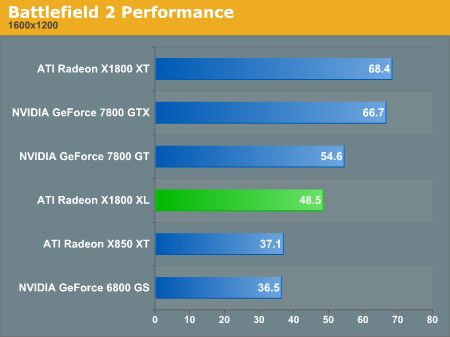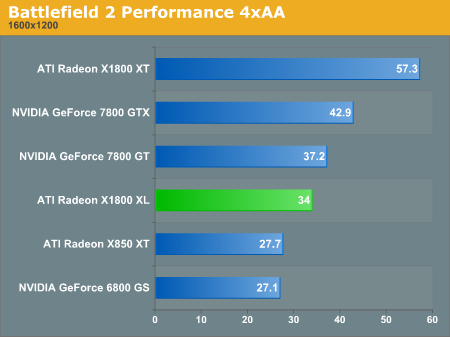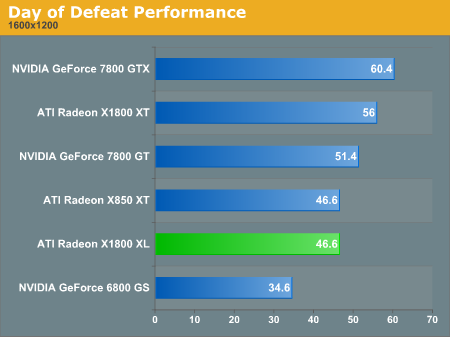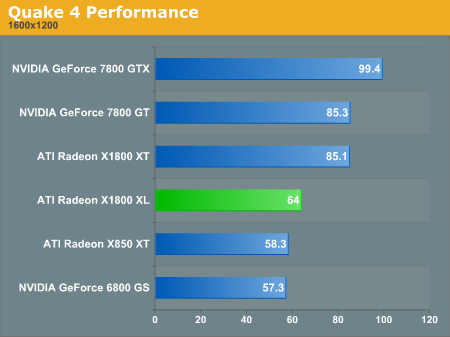ATI's X1800 XL All-In-Wonder: Performance and TV in One Package
by Josh Venning on November 21, 2005 12:30 PM EST- Posted in
- GPUs
Test Setup and Performance
We have already looked at how the X1800 XL performs in different games, but we'll take another look at performance in relation to a few other graphics cards we have. The X1800 XL is one of the most powerful ATI cards out now, and as our tests show, it does a good job at running the latest games smoothly. Here is the test hardware we used: (Note that we test out benchmarks with sound disabled)
Test Hardware
For testing, we chose three games which best reflect the card's overall potential for gaming. Battlefield 2, one of the most popular and graphically demanding first-person-shooters to date still manages to tax the high-end cards significantly. Day of Defeat is an important benchmark for us because the game is based on the Halflife 2 engine, and introduces Valve's recent High Dynamic Range effects which yields much lower framerates than Halflife 2 on all graphics cards. The third game we tested was Quake 4, which gives us an idea of how the card handles the Open Gl Doom 3 engine. We tested each of these games at 1600x1200 with and without 4x AA enabled.






Power Load
We also tested power loads to give us an idea of how much power this card uses at different states. We tested the power draw while the system was idle, as well as running a Splinter Cell benchmark to test the card under stress. We also were curious how much of a power load we saw while recording full screen video through the card. The wattage the system pulled while idle was 157Watts. While recording video at full screen, the power load we recorded was 189Watts. Finally, the power draw of the system while under Splinter Cell stress testing was 256W.
We have already looked at how the X1800 XL performs in different games, but we'll take another look at performance in relation to a few other graphics cards we have. The X1800 XL is one of the most powerful ATI cards out now, and as our tests show, it does a good job at running the latest games smoothly. Here is the test hardware we used: (Note that we test out benchmarks with sound disabled)
Test Hardware
| CPU: | AMD Athlon 64 FX-57 (2.8GHz) |
| Motherboard: | ASUS A8N32-SLI Deluxe |
| Chipset: | NVIDIA nForce4 SLI X16 |
| Chipset Drivers: | nForce4 6.82 |
| Memory: | OCZ PC3500 DDR 2-2-2-7 |
| Video Card: | ATI Radeon X800 XL ATI Radeon X1800 XT ATI Radeon X850 XT NVIDIA GeForce 6800 GS NVIDIA GeForce 7800 GT NVIDIA GeForce 7800 GTX NVIDIA GeForce 7800 GTX 512 |
| Video Drivers: | ATI Catalyst 5.11 (WHQL) NVIDIA ForceWare 81.89 (Beta) |
| Desktop Resolution: | 1280x960 - 32-bit @ 60Hz |
| OS: | Windows XP Professional SP2 |
| Power Supply: | OCZ PowerStream 600W PSU |
For testing, we chose three games which best reflect the card's overall potential for gaming. Battlefield 2, one of the most popular and graphically demanding first-person-shooters to date still manages to tax the high-end cards significantly. Day of Defeat is an important benchmark for us because the game is based on the Halflife 2 engine, and introduces Valve's recent High Dynamic Range effects which yields much lower framerates than Halflife 2 on all graphics cards. The third game we tested was Quake 4, which gives us an idea of how the card handles the Open Gl Doom 3 engine. We tested each of these games at 1600x1200 with and without 4x AA enabled.






Power Load
We also tested power loads to give us an idea of how much power this card uses at different states. We tested the power draw while the system was idle, as well as running a Splinter Cell benchmark to test the card under stress. We also were curious how much of a power load we saw while recording full screen video through the card. The wattage the system pulled while idle was 157Watts. While recording video at full screen, the power load we recorded was 189Watts. Finally, the power draw of the system while under Splinter Cell stress testing was 256W.










27 Comments
View All Comments
bloc - Monday, November 21, 2005 - link
One card consistently performs better though.It's not like one card does better with some demo's and the other card in different ones.
Something to consider...as I think if AT saw the XL beating the GT in all benches, the reviews may be better. As would FS with the inverse.
JarredWalton - Monday, November 21, 2005 - link
Meh. I generally consider the X1800XL and 7800GT to be about equal. The problem is, why would you want to spend extra for a card that includes an old TV-IN chip? Theatre 200 is not that great. If it were a 550, the additional cost would be worthwhile. I think there are far better TV cards out there that could be used with any setup.Personally, I've never been a big fan of the AIW series: upgrade your GPU, and lose the TV tuner function! With other tuner cards, you can move them around to other PCs quite easily and GPU performance isn't a factor. Just my opinion, though.
Doormat - Monday, November 21, 2005 - link
Wow. Nothing mentioned about the whole GPGPU aspect of the X1x00 series of cards. This is the most synergistic part of the whole AIW/X1800 experience. Having the GPU transcode the show on the fly to a suitable format (MPEG4, H264, whatever) for your PSP or your iPod would be an extremely powerful feature.ElJefe - Monday, November 21, 2005 - link
hm what do you mean? didnt aiw already encode and record tv? it does on mine? soemthing different now?I am trully chipper that this card is out. now i can finally buy a new system. My 9800 aiw pro with 754 a64 system is not completely outdated but before summer it will get to be.
No mention of rage 200 vs 550 theater chips and stuff. hm.
gota go check this out. 429 isnt too expensive for it. you get ALOT of stuff with aiw, and also PICTURE QUALITY, something that is never mentioned in reviews, is always superb on them, hm, i guess it's ati again. Nvidia never bothers to excell in this area. a shame really.
Doormat - Monday, November 21, 2005 - link
It records, but what about when I want it to record in MPEG2 for my home viewing, and then transcode it to MPEG4 for my PSP or iPod Video. Thats the single biggest hook for getting people to buy this card - roll your own videos for you device. And not one nary of a mention in the AT article.tayhimself - Monday, November 21, 2005 - link
But is the transcoding accelerated by the AIW card? Some sort of new AVIVO feature? This article does seem to forget about AVIVO which was a big marketing push for the X1x00 series launch.Doormat - Monday, November 21, 2005 - link
No, the transcoding is accelerated by the X1x00 chip, hence my reference to the whole GPGPU thing in my first post.There was an article a few weeks ago about how the X1x00-series chips will have custom programs to transcode video...
http://www.extremetech.com/article2/0,1697,1880749...">http://www.extremetech.com/article2/0,1697,1880749...
Encoding this nearly 5-minute clip, at DVD resolution, takes about 2 minutes 17 seconds with DivX 6, with single-pass encoding at 1 megabit. Windows Media Encoder can produce a high-quality single-pass transcode to WMV9 at 1 megabit in about 4:35. Windows Movie Maker 2 takes a few quality shortcuts to produce a DVD resolution clip at 1.5 megabits in 2:05. That's all pretty good: This is, after all, one of the fastest CPUs money can buy, paired with very fast RAM.
How fast does ATI's new Avivo Transcode app get it done? Try 24 seconds! Okay, that's "give or take a second," because the MPEG-4 profile finished a 1-megabit encode in 23 seconds, the MPEG-2 and Windows Media Video 9 profiles were done in 24, and the DVD profile at 6 megabits finished in 25 seconds. That's all at the default full resolution, too. Crunching down the output resolution by choosing the "WMV9 for PMC (Portable Media Center)" profile at 700 kilobits per second completed the job in 17 seconds.